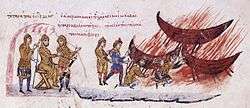Abu Hafs Umar al-Iqritishi


Umar ibn Hafs ibn Shuayb ibn Isa al-Balluti (d. 855), surnamed al-Ghaliz ("the Fat") and later al-Iqritishi ("the Cretan"),[1] and usually known as Abu Hafs (أبو حفص, in Greek sources Ἀπόχαψις, Apohapsis), was a Muladi Barbary pirate and the first Emir of Crete.
After an unsuccessful uprising in Córdoba, Spain in 818 against Emir al-Hakam I the city's Muladi Muslim inhabitants were exiled. Some settled in Fez, Morocco, while a second group, of almost 15,000 men plus women and children, headed for Alexandria in Egypt. With the intention of taking advantage of local unrest, the latter group of rebels selected Abu Hafs as their leader. As leader, Abu Hafs led the group which took control of Alexandria in 816.[2]
After being forced to leave Alexandria, the rebel group set for the Byzantine island of Crete in 827. Upon arriving, they landed at Cape Charax in the gulf of Messara. From there the group headed north under the leadership of Abu Hafs and settled at Chandax near present Heraklion.[3] Abu Hafs and his group of adventurers seized Crete from the Byzantine Empire over the next few years, repelled a number of Byzantine recovery attempts and established an autonomous emirate in the island.[4]
Abu Hafs died in 855 and was succeeded by his son, Shu'ayb ibn Umar.[5]
References
- ↑ Balādhurī, Aḥmad ibn Yaḥyá; Hitti, Philip Khuri (1916). The Origins of the Islamic State, Being a Translation from the Arabic, Accompanied with Annotations, Geographic and Historic Notes of the Kitâb Fitûh Al-buldân of Al-Imâm Abu-l Abbâs Ahmad Ibn-Jâbir Al-Balâdhuri. Columbia university. p. 376.
- ↑ Rogoziński, Jan (1996). Pirates!: Brigands, Buccaneers, and Privateers in Fact, Fiction, and Legend. Da Capo Press. p. 2. ISBN 978-0-306-80722-0.
- ↑ Bakker, Johan de (2003). Across Crete: Part One: From Khaniá to Herákleion. I.B.Tauris. p. 177. ISBN 978-1-85043-387-3.
- ↑ "Byzantine Period, Greece". Archived from the original on 2007-09-28. Retrieved 2007-05-09.
- ↑ Miles, George C. (1964). Byzantium and the Arabs: Relations in Crete and the Aegean Area. vol. 18. JSTOR, www.jstor.org/stable/1291204.: Dumbarton Oaks Papers.
| New title | Emir of Crete ca. 827 – ca. 855 |
Succeeded by Shu'ayb ibn Umar |
